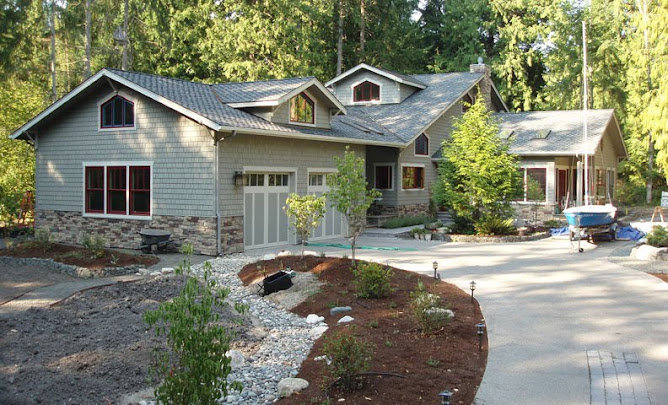 Its time for a little tech talk for my geochemist friends out there (listen up Michele Tuttle).
Its time for a little tech talk for my geochemist friends out there (listen up Michele Tuttle).ABS—Acrylonitrile butadiene styrene (ABS) ((C8H8· C4H6·C3H3N)n) is a common thermoplastic used to make light, rigid, molded products such as low-pressure piping (http://www.ppfahome.org/abs/absgeneral.html). This is the black tubing and fittings that you'll see at Home Depot, etc. Comes in 4 common sizes (inside diameters): 1.5", 2", 3", and 4". I've used all but the 4", which isn't common for houses. However, don't be fooled about the pipe diameters. 1.5" really is 1.9" outside diameter (OD), which is the dimension you'll need to drill most of the holes through your studs. Likewise, 2" pipe is 2.375" OD and 3" pipe is 3.5" OD. This is especially important when you are buying hole saws (bits), such as the Big Hawg Hole Saw (Milwaukee).
ABS pipe and fittings are bonded together by means of chemical fusion. Solvents contained in the cement soften and dissolve the surfaces to be joined. Once the pipe and fitting are assembled, a chemical weld occurs. This weld strengthens over time as the solvents evaporate. My experience is that you have 30 seconds max to move or realign glued up pipe. By the end of the day you'll have black, cement-covered hands. It you screwed up, get out the saw and cut away. The up side is that ABS pipe is cheap and easy to cut with a chop saw. The first photo is of a special musical instrument that I created which attaches to the toilet in the guest bath. Good tunes!
 So far I've used about 250 ft of 1.5" pipe, 120 ft of 2" pipe, 70 ft of 3" pipe, and a gaggle of fittings. Most of the vent piping is done as is the waste piping above the floor. I'm leaving the fun part for last, the waste piping below the floor, which means in the crawl space. This will be mainly 3" (main line) and 2" pipe. The key thing here is to maintain an uniform grade of 1/4" per foot on the pipe, as you all well know from previous postings to this blog. So the pipe either has to go within the floor joists, or more commonly has to be hung below the joists.
So far I've used about 250 ft of 1.5" pipe, 120 ft of 2" pipe, 70 ft of 3" pipe, and a gaggle of fittings. Most of the vent piping is done as is the waste piping above the floor. I'm leaving the fun part for last, the waste piping below the floor, which means in the crawl space. This will be mainly 3" (main line) and 2" pipe. The key thing here is to maintain an uniform grade of 1/4" per foot on the pipe, as you all well know from previous postings to this blog. So the pipe either has to go within the floor joists, or more commonly has to be hung below the joists.  On Friday, I called Bob Brown, my plumbing adviser. Nice guy, stops by to give me the OK on my work. I had laid out all the piping to be installed on the floor, and some assemblies that were glued up but not hung yet (this was a mistake). I screwed up on several counts. My biggest mistake was using an occasional vent part for drainage. The vent elbows and T's have sharp bends, but since they only convey gas there's nothing to get hung up on. Conversely, the drainage parts have medium radius curves (elbows and sanitary Ts) for vertical drops and long-sweep curves for horizontal turns. Herein lie my problems. Looks like I'll be cutting out some glued up ABS and substituting the correct fitting.
On Friday, I called Bob Brown, my plumbing adviser. Nice guy, stops by to give me the OK on my work. I had laid out all the piping to be installed on the floor, and some assemblies that were glued up but not hung yet (this was a mistake). I screwed up on several counts. My biggest mistake was using an occasional vent part for drainage. The vent elbows and T's have sharp bends, but since they only convey gas there's nothing to get hung up on. Conversely, the drainage parts have medium radius curves (elbows and sanitary Ts) for vertical drops and long-sweep curves for horizontal turns. Herein lie my problems. Looks like I'll be cutting out some glued up ABS and substituting the correct fitting.
Another problem was caused by my failure to discriminate between sinks: vanity (i.e., toy sinks) and kitchen sinks (the real thing). Kitchen sinks get all sorts of things down their drains, and thus require 2" piping. Vanities carry soap and water, so they only need 1.5" piping. The only sink I'd actually assembled was the one in the pantry. No big deal, but I need to cut out the offending parts and drill a larger hole down through the floor. More importantly, Bob's checking kept me from screwing up the three other real sinks in the house: the kitchen and prep sinks and the garage sink. If I'd glued up these in 1.5" pipe and fittings, I probably would have waisted a days labor and $100 in parts.
Now that I'm mastering the art of solid plastic piping (ABS), I may move onto PVC and potato guns. I figure if I get some nice big cylindrical Idaho russets and 10" of 3" PVC, I can probably lob a spud onto the Navy ships parked out in Townsend Bay. How does that sound "Sailboat."



